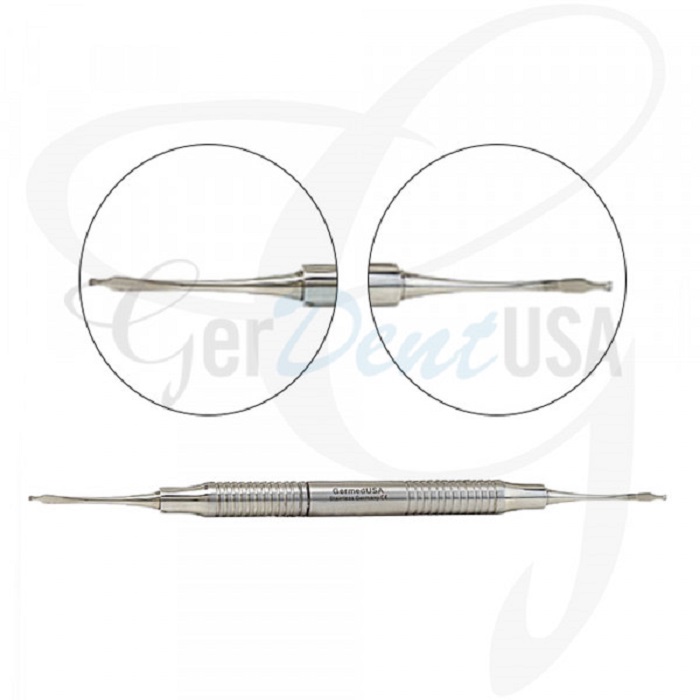Dental implant procedures require several dentistry instruments. These instruments are unique and specific in their structure and function. The implant procedure is a critical job, so the tools are very delicate. Dental chisels play a central role in this procedure. They can be double-ended or single-ended instruments with sharp tips. The blade dimensions and the shaft’s length may vary for different types. A number of variations of the tool are available. It depends upon the procedure requirement or the dentist’s choice of which variation or the type is to use.
Chisel dental instruments help oral surgeons remove, contour, and smoothen the bony areas for the easy insertion of plant material. Besides, they prevent damage to the adjacent structures including, lips, cheeks, and tongue. And thus, chisels make the procedure atraumatic. The procedure’s success depends on how properly the instrument has been used. Moreover, some specific types, like turning chisels, also help during the tooth extraction procedures.
This special dentistry tool has several types. But, the most commonly used are Bone Chisel, Fedi, Kirkland, Ochsenbein, operative, and ridge split chisel. Each one of them is important according to its specifications and use.
Common Dental Chisels
As discussed above, there is a large variety of these dentistry tools. The importance of any instrument depends on how frequently it is used. The same is the case with chisels. Let’s discuss some commonly used dental surgical chisels.
Bone Chisel
This specific type of chisel instrument assists surgeons in shaving and removing bone. Also, it helps split the animal or bone areas. Usually, it has a beveled cutting edge. For tooth splitting purposes, dental experts should prefer a bone chisel with cutting blades on both ends. Often, a bone chisel aids in reshaping and smoothening the bone. If you are a dentist, endodontist, periodontist, oral surgeon, or orthodontist, always prefer stainless steel body chisel instruments. The reason is that they have effective sharpness and durability. Bone dental chisels have several patterns to accommodate multiple requirements.
Operative Chisel
This is a manual, handheld dental instrument with a beveled cutting edge having a small flat blade. Moreover, it has an integral handle for a firm grip. For restorative dental treatment, this specific chisel is useful. For example, during the treatment of dentine defects and tooth enamel, dentists prefer an operative dental surgical chisel. Moreover, it is also workable for refining the cavity preparation. For anterior teeth restorative treatment, it has a straight or mono-angle design. While the teeth at difficult to access, it has contra-angle or bi-angle variations. These chisel instruments also have stainless steel as a primary material, making them durable and robust. Besides, it is available in multiple variations.
Fedi Chisel
This is a periodontal surgical instrument. Experts use it for removing and cutting tissue fibers. Moreover, it is helpful for small bone corrections in difficult-to-reach areas. In flap surgeries, the dentist can make secondary sulcular incisions with this specific chisel. Besides, it helps reshape and remove delicate tissues. If you require interproximal access, use a thin blade Fedi chisel. The stainless steel material makes it reusable. While buying this chisel dental instrument, make sure it has an ergonomic handle grip. As a plus point, the Fedi chisel is useful in all dental surgical procedures.
Ridge Split Chisel
It is usually a single-ended chisel instrument. Dental experts use it to make cuts for lateral ridge augmentation. Thus, it makes implant insertion easier by enhancing bone support. It makes the insertion time faster in graft consolidation. Stainless steel material makes it a rust-free, reusable, and robust dental instrument.
Working Technique of Dental Surgical Chisel
Having various types and variations, a chisel is a multi-tasking dental instrument. Instead of contouring and removing the bony areas for implant purposes, the surgeons also use it for removing the wisdom teeth. For this purpose, oral surgeons prefer turning chisel. They insert the narrow end of the tool between the teeth. Then, turn it carefully. The bone compartment bends when the dentist swiftly turns the chisel. And thus, the tooth detaches from the socket alveolus. Quick movements often cause root fractures. Do not forget to sterilize instruments before use. Also, wear gloves while working with a chisel dental instrument.
Get High-Quality Chisels Dental Surgical Instruments
For an effective treatment procedure, the quality of the surgical instrument is the most important. In the case of dentistry, it becomes more crucial to have prime-quality tools. Being a dental expert, you must evaluate all standard features of your instrument. Otherwise, the patient, as well as your reputation, will bear the brunt. For high-quality dental chisels, contact GerDentUSA Inc. we have medical-grade german stainless steel-made dentistry tools. Also, you can make us manufacture any dental instrument of your choice. Show some trust and you will love our customer care policy.

